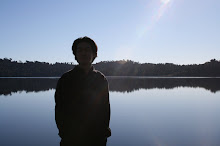As a major tourist destination, Yogya receives a hefty amount of visitors both domestic and international each year. I decide to stop at the tourist information booth in the center of town, to see what type of information they offer to visitors. The lady behind the front counter gave me a large map of the area. On the backside over 30 different destinations in and around Yogya were highlighted, including some lesser known places like villages, a snake fruit agricultural tour, and an education forest. I also found a mini newspaper called the JogjaPages that include articles related to traveling, and more alternative opportunities for touring the surrounding areas like at a pottery village, a copper goods village, village home stay opportunities, and a bamboo handicrafts village. This type of tourism management seems positive as its trying to emphasize the local potential of other interesting, but less visited places.
That evening on a rather stormy night I met with members of the Yogya Green Map club at a little restaurant on the main street of town. I was greeted by Joyo, a young lanky guy in glasses, who is the coordinator of the Indonesian hub of Green Map. Also at the table were Thomas and Inu, other “green mappers.” I hadn’t heard of this group previously, but it is actually a worldwide organization started in New York in 1995, with the head of the Asian hub being in Taiwan. Using Google Earth communities are able to map interesting places in their area, and then make interactive and print maps for distribution. As Joyo explains, the Green Map club provides workshops to those interested in making maps and teaches the universal codes used by all green map members, but it is the community that creates and develops each map.
While Jakarta had the first green map club in Indonesia, the group in Yogya is now the most active. It’s primarily students that create these maps, as they are often very comfortable using computers and are usually more eager to help with volunteer projects. And as Joyo puts it, “the number of socially conscious university students around Yogya has really been a benefit to keeping our group active and focused.” Thomas, Inu, and Joyo told me they first discovered the club about 4 or 5 years ago when they were also university students.
As Joyo goes on to explain, one of the primary benefits of doing the mapping projects is that through the act of making the maps it gets others, especially young people, interested and aware of the assets of their community. By getting the community involved and educated about the interesting features of their area, the group hopes to encourage residents to be more apt to manage and preserve these unique features. “One of the most important steps of the map making” Joyo continued, “is the review process, which acts like a forum where participants can analyze the strengths and weaknesses of various points of interest.” They feel that by discussing weaknesses and strengths of different areas, this will encourage interest in more local community planning.
The next workshop the group is holding is taking place the following Sunday and the Green Map group will be helping to educate the community at Borobudur how to map their area. This will be a special “youth map” created by junior high students, with the purpose of encouraging visitors to extend their stay and visit other places in the local area surrounding the Borobudur World Heritage Site. Currently, most visitors are bused into the temple and then depart, without ever visiting the town or other interesting places and smaller temples around the area. However, as the group explains to me, there are hotels in the area, and inexpensive horse drawn carriages can be hired to visit the lesser known points of interest, thus providing an alternative experience to the routine mass tourism of the area.
In one sentence Joyo was able to sum up the goal of their group, “To empower local people to see their local resources honestly, and to encourage community involvement in planning and managing these assets.” I thanked the group for all the information, and as I left I couldn't help feeling very optimistic to see the passion they have for this work. Green maps really do seem like an innovative idea that can benefit local communities, as well as guests to their area.
Green Maps really is a global endeavor, so to find out more visit: http://www.greenmap.org/













沒有留言:
張貼留言